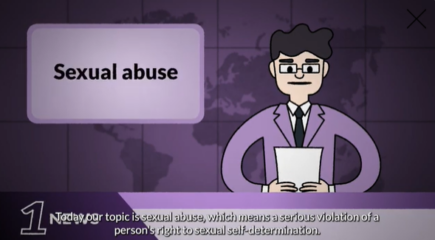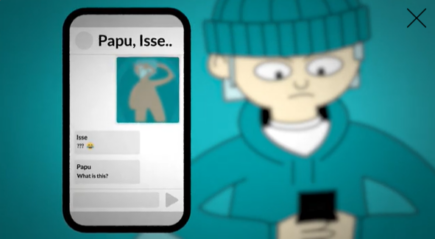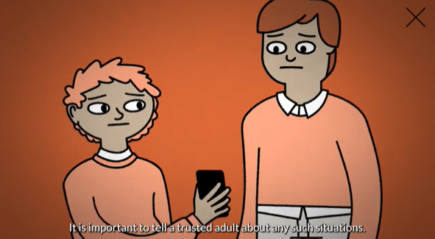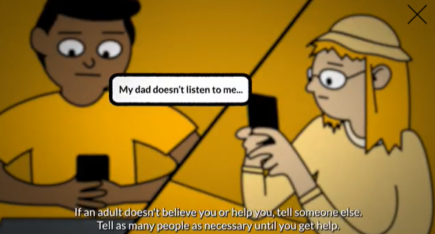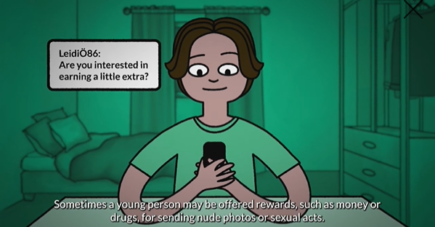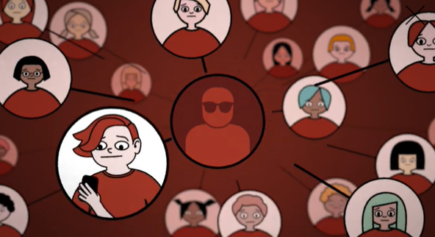How to discuss sexual abuse with a young person? Videos and instructions for a professional
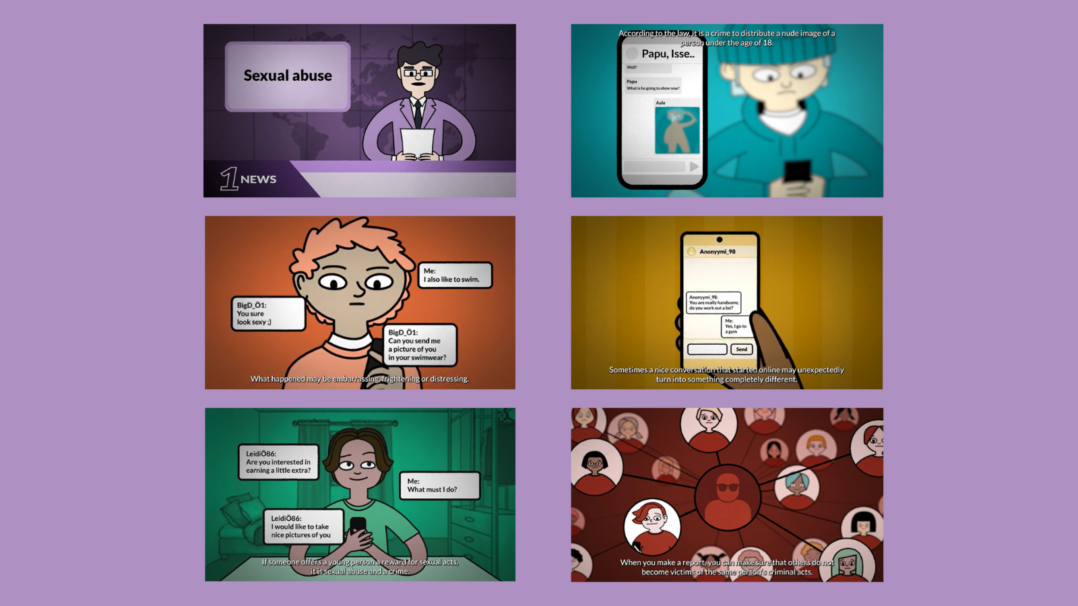
Young people might experience sexual abuse on social media, such as requests, messages and photos with sexual content sent by an adult. Does the young person know that an adult is not allowed to send such messages to them? Would the young person recognise that also their peer can commit a crime, for example by refusing to remove from their phone someone’s nude photo, that was originally shared with consent?
Would the young person tell a safe adult, such as a parent, a teacher, a school health nurse, or a youth worker about the situation? According to the Grooming in the eyes of a child report by Save the Children Finland, many children and young people would not disclose their sexual abuse to an adult.
This page has 6 videos produced by Save the Children Finland’s Finnish Hotline Nettivihje. The videos have information about child sexual abuse: identifying it, preventing it, reporting, and seeking support. The videos were made in collaboration with young people. After each video, there are tips for discussing the topic with young people.
How to use this page in your work with young people
- Watch the videos on your own first. If necessary, familiarise yourself with the provided further information and seek more information. Reflect on your feelings and thoughts.
- Before showing the videos to the young people, let them know who they can talk to, if the videos and the conversations afterwards bring up difficult feelings or a need to discuss their experiences. For example, let them know when the school health nurse or welfare officer is available, if they want to talk. It is better to share these thoughts with an adult in private, instead of in a group setting.
- Watch the videos together with the young people and discuss your thoughts on a general level. Not all young people might want to share their thoughts. Give these young people the opportunity to reflect independently and, for example, write down their thoughts and answers.
- Below each video, you will find questions to help initiate a conversation.
- You can go through all 6 videos or only a part of them. The first video is an introduction to the topic.
- After having these conversations with young people, it is good to have some time for more relaxed conversations and calming down, before the young people leave or move to other tasks. You can, for example, discuss what makes a good relationship or what things make the young people feel good in difficult moments.
Video 1. Extra news broadcast
Watch video 1 in Finnish
Watch video 1 in Swedish
Watch video 1 in Northern Sámi
Before discussing this video with young people, it is good to familiarise yourself with your national legislation on sexual offences against children and the age of consent. These are topics on which the young people might have questions. For example, can a young person commit a crime by sharing their own nude image with a peer?
Questions for young people
- What other words or terms might a young person use to describe these situations?
- What terms are unclear?
More information
A website on the new Finnish legislation on sexual offences by the Ministry of Justice.
Video 2. Another young person can also commit sexual abuse
Watch video 2 in Finnish
Watch video 2 in Swedish
Watch video 2 in Northern Sámi
Many young people send intimate or nude pictures to another young person. In Finland, that is legal and OK, if both have consented to the sharing of pictures. The Finnish Criminal Code has a restrictive provision, which means that young people who are approximately of the same age, can do sexual acts together, if both consent.
Criminal code, chapter 20, 17 §: Restrictive provision: ”An act shall not be deemed rape of a child, sexual assault of a child or sexual abuse of a child, if it does not violate the right to sexual self-determination of the person at whom the act is directed and if there is no great difference in the age and maturity of the parties involved.”
A young person can, however, commit a sexual offence if there is no consent. In Finland, the age of criminal liability is 15 years. This means that a young person of that age and older can be held responsible for their actions in criminal proceedings. A child younger than 15 can be liable for damages.
A young person may not understand that they are committing a crime if they spread another young person’s nude pictures. This is why it is important to discuss with young people, what consent and lack of consent mean. All sexual activity requires mutual consent, and everyone has the right to, at any point, withdraw their consent. That means they can let the other person(s) know they do not want to continue the activity or, as in the video, ask someone to remove the pictures they have shared. If the other person does not act accordingly, they might be committing a crime. It is important for young people to learn how to ask, what the other person wants, and to express what they want or what feels nice and good. Giving consent once is not enough, it has to be checked and given again every time.
Questions for young people
- Why do you think Aale sent Ruu’s picture to their friends?
- What do you think of how Isse and Papu acted?
- Who could be a safe adult that you could tell, if your picture or your friend’s picture was spread?
More information
Watch Thames Valley Police’s video Tea and consent.
Video 3. Sexual abuse can be difficult to identify
Watch video 3 in Finnish
Watch video 3 in Swedish
Watch video 3 in Northern Sámi
Young people can find it very easy to start a conversation with an adult online. Reasons for starting a conversation can be, for example, boredom, curiosity, or not fully understanding what is happening. A young person can struggle to identify the risks related to the contact, and the adult can be very skilled in getting the young person to comply.
Grooming is a complex phenomenon and there is not one clear pattern that grooming always follows. A perpetrator can manipulate a young person in many different ways. The perpetrator might, for example, flatter and compliment the young person excessively, ask to move to a private conversation, try to extract personal information, or ask the young person to keep the contact secret. Sometimes the perpetrator can repeatedly ask the young person to do something, even if the young person already said no. It is, therefore, important to highlight to young people, that it others should respect their boundaries and take no for an answer.
For situations that start to seem suspicious or give the young person anxiety, they should be supported in trusting their own feelings and listening to them. If, at some point, the contact starts to feel bad, it would be important that the young person discusses the situation with a safe adult, who could help them.
Questions for young people
- How should someone act, if they start talking online to a person they haven’t previously met?
- How can someone pick up on the fact that the other person wants the chatting to lead to something more intimate?
- How might a young person feel if they get messages with sexual content from an adult?
More information
Save the Children Finland’s report Grooming in the eyes of a child (pdf).
Video 4. Don’t be left alone with what happened
Watch video 4 in Finnish
Watch video 4 in Swedish
Watch video 4 in Northern Sámi
Young people most often disclose their experience of sexual abuse to a friend. This can make the young person feel better after their experience, but the situation can weigh on the other young person. Also, the young person with a sexual abuse experience doesn’t receive the support they need. For this reason, young people should be encouraged to disclose also their friend’s sexual abuse experience to a safe adult.
A young person might be afraid that revealing a friend’s secret will cause problems with that friend. However, it would be important to emphasise that a good friend cares for their friend’s wellbeing and it is important to seek help for one’s friend. Sometimes it can be very difficult for a young person to bring up their sexual abuse experience, but when someone else starts the conversation, disclosing becomes easier. At the same time, the other young person no longer needs to keep the secret, and both young people’s wellbeing is supported.
Let young people know of the support services.
Questions for young people
- How can someone help their friend who has experienced sexual harassment or sexual abuse?
- What things could help someone tell an adult? How do you find it easiest to talk about difficult topics with an adult?
- Why might it be difficult to tell an adult what happened? Why is it still worth it to tell?
Video 5. The perpetrator of sexual abuse is always the responsible party
Watch video 5 in Finnish
Watch video 5 in Swedish
Watch video 5 in Northern Sámi
In Finland, the Criminal Code (Chapter 20: section 9) forbids offering compensation to an under 18-year-old for sexual acts.
An adult can try to use a young person’s need for something specific, like clothes, appliances, or money, to their advantage. Sometimes an adult might offer, for example, alcohol or narcotics as a reward. A young person might agree to sexual acts in exchange for a reward but might later on notice that the situation isn’t without problems. What happened might start to make the young person feel anxious. They might also be blackmailed to stay in contact with the adult.
Sometimes a young person can be afraid that because they accepted the reward, they will be blamed for what happened. It is, therefore, important to explain to young people that regardless of rewards they might have received, a young person is never to blame for the sexual abuse they experienced. The person who did wrong is the adult who committed the crime.
Questions for young people
- Why might a young person agree to offers like this?
- Why might it be difficult to stop being in contact with the other person? How could a young person stop staying in contact?
- When do you feel good and safe?
Video 6. By reporting, you can help others as well
Watch video 6 in Finnish
Watch video 6 in Swedish
Watch video 6 in Northern Sámi
Many young people do not disclose the sexual abuse they experience. Professionals should lower the threshold of disclosure by encouraging a young person to talk about embarrassing and difficult topics to an adult. They should also make disclosure easier by letting the young person know that there is a reason why disclosing is important. By disclosing, the young person can receive help and the perpetrator can be held responsible for their actions. The more young people disclose, the better we can combat sexual abuse overall. Unfortunately, young people have gotten used to facing sexual abuse, especially online, but this should definitely not be the case. Disclosing is brave and makes things better for everyone, including other children and young people.
In Finland, cases have come to light recently, with one perpetrator having up to hundreds of victims. These cases have come to the police through a single report. Even one report can, therefore, be significant. A young person might, still, believe that disclosing will not change anything.
More information
List of support services for young people.
Information about the project
The videos have been produced with funding for the implementation of the programme to combat violence against women from the Ministry of Justice. In the project, together with young people and the production company, six animated videos were developed. The videos deal with different forms of child sexual abuse, reporting it and getting help. The goal is to increase the awareness of young people between the ages of 11 and 17 about sexual harassment and sexual abuse on the internet and on social media. By increasing awareness, young people are helped to protect themselves and their own boundaries and to disclose their experiences to an adult.
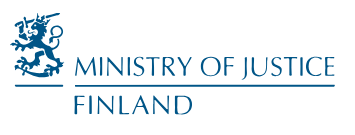
The contents of this publication are the sole responsibility of Save the Children Finland and do not necessarily reflect the opinion of the European Union.
